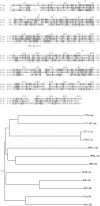The human TPR protein TTC4 is a putative Hsp90 co-chaperone which interacts with CDC6 and shows alterations in transformed cells
- PMID: 18320024
- PMCID: PMC2253824
- DOI: 10.1371/journal.pone.0001737
The human TPR protein TTC4 is a putative Hsp90 co-chaperone which interacts with CDC6 and shows alterations in transformed cells
Abstract
Background: The human TTC4 protein is a TPR (tetratricopeptide repeat) motif-containing protein. The gene was originally identified as being localized in a genomic region linked to breast cancer and subsequent studies on melanoma cell lines revealed point mutations in the TTC4 protein that may be associated with the progression of malignant melanoma.
Methodology/principle findings: Here we show that TTC4 is a nucleoplasmic protein which interacts with HSP90 and HSP70, and also with the replication protein CDC6. It has significant structural and functional similarities with a previously characterised Drosophila protein Dpit47. We show that TTC4 protein levels are raised in malignant melanoma cell lines compared to melanocytes. We also see increased TTC4 expression in a variety of tumour lines derived from other tissues. In addition we show that TTC4 proteins bearing some of the mutations previously identified from patient samples lose their interaction with the CDC6 protein.
Conclusions/significance: Based on these results and our previous work with the Drosophila Dpit47 protein we suggest that TTC4 is an HSP90 co-chaperone protein which forms a link between HSP90 chaperone activity and DNA replication. We further suggest that the loss of the interaction with CDC6 or with additional client proteins could provide one route through which TTC4 could influence malignant development of cells.
Conflict of interest statement
Figures







References
-
- Pearl LH, Prodromou C. Structure and in vivo function of Hsp90. Curr Opin Struct Biol. 2000;10:46–51. - PubMed
-
- Beliakoff J, Whitesell L. Hsp90: an emerging target for breast cancer therapy. Anticancer Drugs. 2004;15:651–662. - PubMed
-
- D'Andrea LD, Regan L. TPR proteins: the versatile helix. Trends Biochem Sci. 2003;28:655–662. - PubMed
-
- Smith RL, Redd MJ, Johnson AD. The tetratricopeptide repeats of Ssn6 interact with the homeo domain of alpha 2. Genes Dev. 1995;9:2903–2910. - PubMed
Publication types
MeSH terms
Substances
LinkOut - more resources
Full Text Sources
Medical
Molecular Biology Databases

